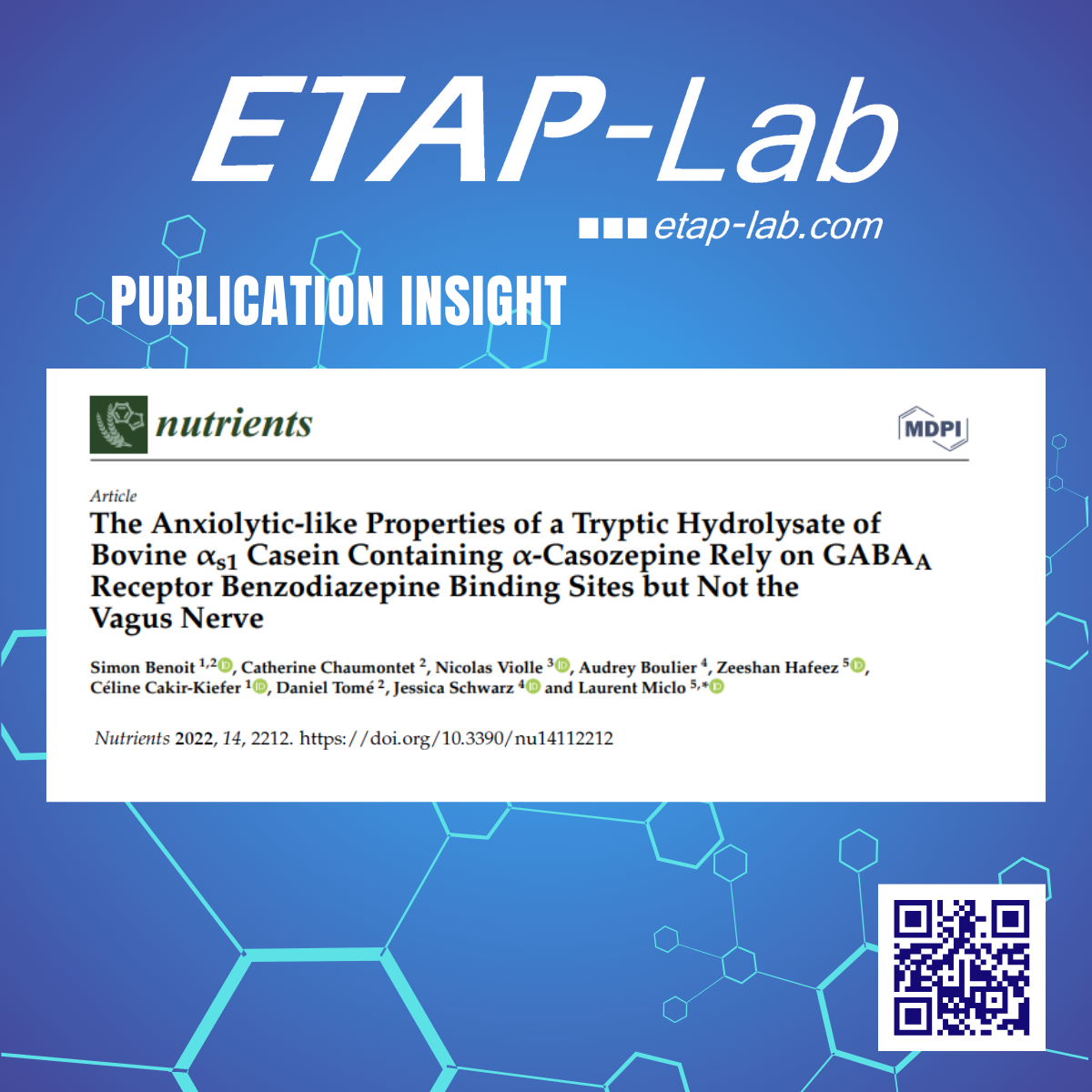A signifiant milestone for our publication on Nutrients journal
We wanted to highlight on our recent article on our psychopharmacology research "The Anxiolytic-like Properties of a Tryptic Hydrolysate of Bovine αs1 Casein Containing α-Casozepine Rely on GABAA Receptor Benzodiazepine Binding Sites but Not the Vagus Nerve" that has reached over 3000 views in MDPI Nutrients journal! The published data on the anxiolytic-like properties of bovine αs1-casein (CH) support that: α-casozepine is responsive for the anxiolytic-like effects of the alpha-s1-casein tryptic hydrolysate (CH). CH anxiolytic-like effects are not mediated by the
Improving Stroke Outcomes in Hyperglycemic Mice by Modulating tPA/NMDAR Signaling to Reduce Inflammation and Hemorrhages
The pharmacological intervention for ischemic stroke hinges on intravenous administration of the recombinant tissue-type plasminogen activator (rtPA, Alteplase/Actilyse®) either as a standalone treatment or in conjunction with thrombectomy. However, despite its clinical significance, broader employment of rtPA is constrained due to the risk of hemorrhagic transformations (HTs). Furthermore, the presence of diabetes or chronic hyperglycemia is associated with an elevated risk of HT subsequent to thrombolysis. This detrimental impact of tPA on the neurovascular unit in hyperglycemic patients has been
Dynamics of cerebral blood volume during and after middle cerebral artery occlusion in rats – Comparison between ultrafast ultrasound and dynamic susceptibility contrast-enhanced MRI measurements
Tomographic perfusion imaging techniques are integral to translational stroke research paradigms that advance our understanding of the disease. Functional ultrasound (fUS) is an emerging technique that informs on cerebral blood volume (CBV) through ultrasensitive Doppler and flow velocity (CBFv) through ultrafast localization microscopy. It is not known how experimental results compare with a classical CBV-probing technique such as dynamic susceptibility contrast-enhanced perfusion MRI (DSC-MRI). To that end, we assessed hemodynamics based on uUS (n = 6) or DSC-MRI (n =
A New Moisturiser Improves DNCB-induced Atopic Dermatitis-like Symptoms and Restores Skin Barrier Function in BALB/c Mice
Evaluation of a New Moisturiser for Atopic Dermatitis in a Murine Model Introduction Atopic dermatitis (AD) is a chronic, inflammatory skin disorder with eczematous and pruritic lesions. Topical moisturisers and either topical corticosteroids or calcineurin inhibitors are usually recommended. Restoring the skin barrier function alleviates AD symptoms. Objective To evaluate the efficacy of a new moisturiser compared to commercially available products in an AD murine model. Methods Experimental AD was induced with topical applications of 2,4-DiNitroChloroBenzene (DNCB) on the shaved back skin of BALB/c mice from
The Anxiolytic-like Properties of a Tryptic Hydrolysate of Bovine αs1 Casein Containing α-Casozepine Rely on GABAA Receptor Benzodiazepine Binding Sites but Not the Vagus Nerve
The Anxiolytic-like Properties of a Tryptic Hydrolysate of Bovine αs1 Casein Containing α-Casozepine Rely on GABAA Receptor Benzodiazepine Binding Sites but Not the Vagus Nerve(CH) Background A tryptic hydrolysate of bovine αs1-casein (CH) exerts anxiolytic-like properties in many species, including humans. This is mainly related to the presence of α-casozepine (α-CZP), which yields these properties in rodents. This study evaluates, in a rat model, the roles of the vagus nerve and the benzodiazepine binding site of GABAA receptors in the mode of
Antitumor Effect and Induced Immune Response Following Exposure of Hexaminolevulinate and Blue Light in Combination with Checkpoint Inhibitor in an Orthotopic Model of Rat Bladder Cancer
Previous studies have found that use of hexaminolevulinate (HAL) and blue light cystoscopy (BLC) during treatment of bladder cancer had a positive impact on overall survival after later cystectomy, indicating a potential treatment effect beyond improved diagnostic accuracy. The aim of our study was to determine whether HAL and BL mimicking clinically relevant doses in an orthotopic rat model could have therapeutic effect by inducing modulation of a tumor-specific immune response. We also assessed whether administration with a checkpoint inhibitor
Post-acute delivery of α5-GABAA antagonist, S 44819, improves functional recovery in juvenile rats following stroke
Hypo-excitability was reported in the peri-infarct tissue following stroke, an effect counteracted by a blockage of α5-GABAA receptors in adult rodents. Our present study aims to evaluate the effect of a selective α5-GABAA receptor antagonist, S 44819, in stroke in juvenile animals. We have set up and characterized an original model of transient ischemic stroke in 28 day-old Sprague-Dawley rats (45-min occlusion of the middle cerebral artery by intraluminal suture). In this model, S 44819 (1, 3 and 10 mg/kg,
Early Ultrafast Ultrasound Imaging of Cerebral Perfusion correlates with Ischemic Stroke outcomes and responses to treatment in Mice
In the field of ischemic cerebral injury, precise characterization of neurovascular hemodynamic is required to select candidates for reperfusion treatments. It is thus admitted that advanced imaging-based approaches would be able to better diagnose and prognose those patients and would contribute to better clinical care. Current imaging modalities like MRI allow a precise diagnostic of cerebral injury but suffer from limited availability and transportability. The recently developed ultrafast ultrasound could be a powerful tool to perform emergency imaging and long
Evaluation of the antidepressant- and anxiolytic-like effects of a hydrophilic extract from the green seaweed Ulva sp. in rats
OBJECTIVES: The green seaweed Ulva sp. contains a large amount of ulvans, a family of sulphated polysaccharides. The present study was designed to investigate in rats the antidepressant- and anxiolytic-like effects of a hydrophilic extract of Ulva sp. (MSP) containing about 45% of ulvans.METHODS: After a 14-day administration of MSP at doses of 10, 20 and 40 mg/kg/day, 48 and 60 male adult Wistar rats were respectively tested in the elevated plus-maze (EPM) and the forced swimming test (FST). In the
Lactobacillus salivarius LA307 and Lactobacillus rhamnosus LA305 attenuate skin inflammation in mice
Oral probiotics potential for the management of dermatological diseases is vast. However, results of available studies in skin diseases, such as atopic dermatitis (AD), are inconsistent, partly because probiotic effects are strain specific. Careful selection of probiotic strains is therefore indispensable to ensure efficacy of treatment. In this study, Lactobacillus salivarius LA307, Lactobacillus rhamnosus LA305 and Bifidobacterium bifidumPI22, three strains that were previously identified for their interesting immunomodulatory properties in allergy and/or colitis models, were assessed in the prevention of



